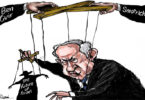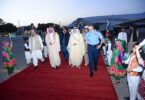Monitoring Desk
BEIRUT: It’s mid-February in Beirut and the visual artist Adra Kandil is discussing old photographs in a café on Bliss Street. Although in her mid-20s, she has cultivated a deep attachment to photography from the 1960s — particularly Lebanon’s Golden Age and the imagery associated with the country’s pre-war heyday. For her, such photographs represent something that has been irretrievably lost.
“My memories are amplified and seem much better than they really were,” she says. “I romanticize memories. That’s the thing with time passing: It glorifies what you once had. I construct from that feeling — the happiness, the melancholy; all of it.”
It is this loss and sentimentality that drives Kandil’s work: a collection of collages and compositions that have a nostalgic, dreamlike quality. There are old newspapers, flowers, film stars, vintage cityscapes, Air Liban tickets, coffee cups and classic cars in her artwork, which she releases under the moniker Dear Nostalgia. In many the moon features prominently.
“I create from an accumulation of memories, feelings, scents and sounds,” says Kandil, whose work enables her to explore themes of childhood, home and identity. “My memory is very much based on my sensory experiences. I am inspired by what once was, and inspired by collecting and putting things together from my past, or a collective past. My work always has a message and the process isn’t linear. Sometimes an old photograph inspires me, sometimes a new song from my playlist, sometimes a story about my father’s childhood.”
She’s far from alone. A new generation of artists and designers have embraced the imagery of their collective past. From cultural icons including Umm Kulthum, Fayrouz, Sabah, Abdel Halim Hafez and Asmahan, to vintage signs and photographs of old Beirut and Damascus, there’s a palpable sense of nostalgia to much of their work. Even the scripts these artists use are synonymous with certain eras: Ruqʿah, for example, a shorthand script often associated with Egyptian movie posters.
Examples of work from a number of these artists and designers can be found on Arabic Pop Art, an Instagram account that curates pop and collage art inspired by Arab culture. There’s Stephany Sanossian, who places modern pop-culture figures in old Arab settings, and Saba Mousavi, who goes by the name sad.mim.art and has a fondness for the Palestinian cause.
“There’s something visually charming about nostalgia which gives you that dreamy, romantic feel which a lot of people might prefer over today’s more minimalistic, or even more realistic, visual approach,” says Paola Mounla, the founder of Art of Thawra, an Instagram account that curates art related to Lebanon’s recent protests. “That said, when it comes to Lebanon, the common feeling among the Lebanese is that the country’s best days were pre-war, and so any art that is nostalgic will bring out that feeling of ‘Oh, those good old days.’”
That this sense of nostalgia is noticeably stronger in Lebanon and Palestine is understandable. The former has seen its cities scarred by war and its landscape butchered by political and corporate greed. The latter has seen its people displaced and its land stolen. This sense of loss is now being felt in Syria too.
But there’s also a more universal feeling. One that involves the reclamation of the past and a celebration of Arab culture, says the Lebanese designer Rana Salam, who has used pop-culture imagery to create everything from posters and bags to cushions and towels. For her, Egyptian or Lebanese cultural icons, just like those of other countries, are key to setting those countries apart and to challenging prevailing perceptions of the Arab world.
“I was studying in London and felt that the British had no clue what the Middle East or Beirut looked like,” says Salam, who first captured her distinctive visual style in 1992. “And as I majored in visual communication and art direction at the Royal College of Art, I was taught how to translate a culture by highlighting its strength. And for me pop culture spoke the loudest.
“Nostalgia is one way of reaching people emotionally… and I know that I was part of an awakening for a past that had been disposed of and undervalued,” she continues. “And by reviving the past I have made many fall in love with their culture, have pride in their culture, and focus on local ideas and production rather than importing only Western ones.”
It’s not all positive. There are those who would describe nostalgia as a malaise. As an emotion that throws a golden glow around the past and distorts the collective memory.
“I feel we need to draw the difference between a nostalgic message and a nostalgic visual style,” says Mounla. “In both Adra and Stephany’s case, the visual style is nostalgic but the message is always progressive and anchored in today. In this case, I feel they’re creating something totally new and I’m not even sure it should be labeled as ‘nostalgia.’”
Kandil’s work addresses issues of nationality, culture and social and political change, while Dana Barqawi — a Palestinian artist whose work celebrates Palestinian existence and culture — portrays the people of the land before 1948 using old photographs, ink, newspaper, gold leaf and thread. For both artists, nostalgia is used for a purpose. Dig beneath the aesthetics and you’ll find strong political and social messages.
For Barqawi, that has meant challenging the widely cited rhetoric that Palestine was ‘a land without a people for a people without a land’. That’s why all of the photographs she uses were taken “before the land and its people were forcibly removed and displaced.”
“Nostalgia is defined as the sentimental yearning for a return to a past period or place with happy personal associations,” says Barqawi, who lives in Amman and whose work is currently being exhibited at the Museum of the Palestinian People in Washington DC. “I come from a diaspora generation that mostly only heard about Palestine from first generations who either romanticized it or never wanted to speak of the past because it was too painful. My generation developed a sense of belonging to a place they’ve never seen or been to, a place they never lived in. Palestine became more than just a place; it became a concept of justice, freedom, resistance, existence, beauty, but also the sadness that comes with something unattainable.
“I intend that my act of artistic creation is inseparable from notions of the real world. In times where socio-political changes compose an inherent part of our reality, I choose to reflect the context within my work, consequently creating politically and socially engaged art,” she continues. “I might use nostalgia to appeal to an audience on a feel-good level — (just as) I use beauty in my work as a tool to attract the viewer — but beyond the pleasing nature of the work, and below those aesthetic layers, there is a political agenda which challenges the institutional invisibility of Palestinian history and experience.”
Courtesy: (Arabnews)






